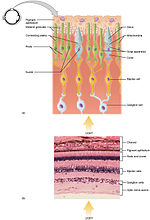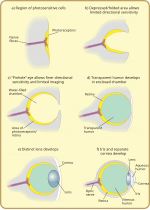Vertebrate visual opsins are a subclass of ciliary opsins and mediate vision in vertebrates. They include the opsins in human rod and cone cells. They...
10 KB (1,049 words) - 21:31, 14 July 2024
membrane (i.e. hyperpolarization.) Vertebrate visual opsins are a subclass of ciliary opsins that express in the vertebrate retina and mediate vision. They...
86 KB (9,311 words) - 19:43, 15 November 2024
cells (rods and cones) in the vertebrate retina. A photon is absorbed by a retinal chromophore (each bound to an opsin), which initiates a signal cascade...
20 KB (2,366 words) - 05:14, 10 September 2024
Photoreceptor cell (redirect from Vertebrate photoreceptor)
apply to the phototransduction pathway from vertebrate rod/cone photoreceptors are: The Vertebrate visual opsin in the disc membrane of the outer segment...
26 KB (2,939 words) - 00:26, 2 November 2024
protein molecules called opsins. In humans, two types of opsins are involved in conscious vision: rod opsins and cone opsins. (A third type, melanopsin...
59 KB (6,928 words) - 00:56, 3 November 2024
Visible spectrum (redirect from Visual spectrum)
wavelengths that can both reach the retina and trigger visual phototransduction (excite a visual opsin). Insensitivity to UV light is generally limited by...
37 KB (4,028 words) - 23:47, 12 November 2024
Melanopsin (redirect from Opsin 4)
related to invertebrate visual opsins, which are rhabdomeric opsin, than to vertebrate visual opsins, which are cliary opsins. This is also reflected...
39 KB (4,525 words) - 07:01, 5 April 2024
Eye (redirect from Eye (vertebrate))
eyes of vertebrates usually contain ciliary cells with c-opsins, and (bilaterian) invertebrates have rhabdomeric cells in the eye with r-opsins. However...
60 KB (7,514 words) - 13:52, 4 October 2024
Retinylidene protein (section Visual perception)
forms of opsin and rhodopsin (in the broad sense). While rhodopsin in the narrow sense refers to a dim-light visual pigment found in vertebrates, usually...
12 KB (1,416 words) - 05:06, 29 November 2023
that encode the L-opsin or M-opsin. These alleles often have a different spectral sensitivity, so if the carrier expresses both opsin alleles, they may...
25 KB (2,786 words) - 19:40, 2 November 2024
rhabdomere is packed with about 100 million opsin molecules, the visual protein that absorbs light. The other visual proteins are also tightly packed into the...
145 KB (16,706 words) - 00:59, 29 October 2024
George Wald (category Visual system)
when the pigment rhodopsin was exposed to light, it yielded the protein opsin and a compound containing vitamin A. This suggested that vitamin A was essential...
16 KB (1,497 words) - 14:27, 27 September 2024
rhodopsin, the vertebrate photoreceptor molecule. Rhodopsin is composed of the 11-cis-retinal covalently linked via a Schiff base to the opsin protein (either...
47 KB (5,127 words) - 17:14, 18 October 2024
Lancelet (section Visual system)
before turning and exiting. The cells bear the opsin c-opsin 1, except for a few which carry c-opsin 3. The Row 2 cells are serotonergic neurons in direct...
63 KB (6,459 words) - 11:48, 16 November 2024
Trichromacy (category Visual system)
the visual cortex as well. On the other hand, the L and M cones are hard to distinguish by their shapes or other anatomical means – their opsins differ...
14 KB (1,585 words) - 16:03, 2 November 2024
one rod opsin class (rhodopsin, Rh1), all of which were inherited from early vertebrate ancestors. These five classes of vertebrate visual opsins emerged...
13 KB (1,429 words) - 21:39, 14 July 2024
their cones is sensitive. In vertebrates, the dimensionality of the color gamut is usually equal to the number of cones/opsins, though this simple equivalence...
31 KB (3,830 words) - 02:32, 8 September 2024
Retina (category Visual system)
tissue of the eye of most vertebrates and some molluscs. The optics of the eye create a focused two-dimensional image of the visual world on the retina, which...
84 KB (9,299 words) - 13:58, 2 November 2024
vertebrates, including humans. Indeed, "the basic pattern of all vertebrate eyes is similar." Five classes of visual opsins are found in vertebrates....
45 KB (5,464 words) - 15:52, 2 November 2024
Color vision (category Visual perception)
trichromats. Visual sensitivity differences between males and females in a single species is due to the gene for yellow-green sensitive opsin protein (which...
64 KB (7,926 words) - 12:59, 18 November 2024
structure. Cone photoreceptors are conical in shape and contain cone opsins as their visual pigments. There exist three types of cone photoreceptors, each being...
47 KB (5,789 words) - 00:32, 16 November 2024
Opsins are members of the G protein-coupled receptor superfamily. In addition to the visual opsins, mammals possess several photoreceptive non-visual...
6 KB (704 words) - 20:21, 3 March 2023
to opsin-type photoreceptor proteins, specifically rhodopsin and photopsins, the photoreceptor proteins in the retinal rods and cones of vertebrates that...
3 KB (328 words) - 02:33, 16 July 2021
of vertebrate eyes. These cells undergo phototransduction cascades (process of light absorption by photoreceptors) that are triggered by c-opsins. Available...
119 KB (12,438 words) - 16:11, 9 November 2024
other molluscs.) In contrast, the vertebrate eye is normally insensitive to polarization differences because the opsins in rods and cones are arrayed semi-randomly...
11 KB (1,262 words) - 07:21, 23 August 2024
motion and polarization vision. Some double cones have members with same opsin (twin cones), while others have members with different cone types (members...
3 KB (382 words) - 18:15, 30 August 2022
Vision in fish (section Water as a visual environment)
origin of the Vertebrate Eye, 2008. Trevor D. Lamb; Shaun P. Collin; Edward N. Pugh Jr (2007). "Evolution of the vertebrate eye: opsins, photoreceptors...
66 KB (7,937 words) - 05:00, 12 November 2024
Optogenetics (section Visual system)
behaving mammals is now also possible. Building on prior work fusing vertebrate opsins to specific G-protein coupled receptors a family of chimeric single-component...
108 KB (11,917 words) - 14:05, 15 November 2024























